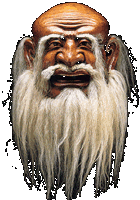|

Video Introduction 
 |
|
|
Tsaghan
Ebügen, the White Old Man
Papier-mâché mask, horse’s hair, and cotton;
19th century
Attributed to Puntsag Osor
Robe: silk with cotton lining; 19th—20th century
Museum of Fine Arts, Ulaan Baatar
At the Tsam festival the White Old Man represents the ancient
shamanistic gods of Mongolia, who were absorbed into the Buddhist
pantheon but assigned only a secondary role. Tsaghan Ebügen
is the Protector of Cattle and can prevent various diseases
in animals. Though of Tibetan origin, he has assumed the appearance
and function of Shoulao, the Chinese God of Longevity. Armed
with a staff with a dragon-shaped finial, the White Old Man
performed the role of a buffoon. Moving along the edge of the
Tsam square, he caricatures the solemn dances. Popular superstition
explains his association with longevity: Those who were hit
by the sticks of the Lords of the Charnel Grounds were believed
to die within the year. Only by receiving another hit by the
staff of Tsaghan Ebügen could they be ensured a longer
life.
|
Since time immemorial Mongolia has been
occupied by tribes whose nomadic existence was dictated by the rugged
topography and extreme climate of this vast region. More often fragmented
than unified, these tribes, nevertheless, shared similar cultures
and religious beliefs. Shamanism, an indigenous cult, was an amalgam
of beliefs and practices centered on the shaman,. The
shaman was a figure who acted as an intermediary between the
human and spirit worlds. Lamaism, a form of esoteric or mystical
Buddhism introduced from Tibet, however, became the dominant
institutionalized religion and the catalyst for large-scale
festivals.
Among the most colorful and fascinating of these festivals were
the masked dance ceremonies known as Tsam.
These ceremonies, introduced in the eighteenth century, were held
around the New Year with the purpose of destroying the evil that
had accrued during the past year. Performed by monks, the characters
portrayed in the dances included a wide variety of terrifying deities
from the Lamaist pantheon. Shamanistic deities also made cameo appearances,
and shamanistic motifs were often incorporated into the costumes
and masks. So compelling are the masks and so strong was the exorcistic
atmosphere of the ceremonies that nineteenth-century Western travelers
in Mongolia dubbed them the devil’s dances.
With the brutal repression of religion and the destruction of monasteries
in the region by the Russian Communist regime in the 1930s, Tsam
and other ceremonies were forbidden and many of the masks and paraphernalia
destroyed. Today, however, in newly independent Mongolia Tsam ceremonies
are once again being performed.
|

